Ah gender roles. That tropiest of tropes. That shortcut to characterization and tool of half-hearted writers everywhere. Thank goodness there’s none of that nonsense in Gekkan Shoujo Nozaki-kun. Well, there is, but its all the wrong way round. Which is (one of) the reasons why this show is great.
I mentioned briefly in Part 1 how the violation of traditional gender roles plays into the comedy: the role of slapstick in Hori and Kashima’s interactions and Seo’s propensity to be hilariously oblivious and tease poor anxious Wakamatsu, for example. But subverting gender roles is used for more than just laughs. It creates complex characterization and interesting characters. It says something about society and media. But that’s in Part 4, so I’m getting ahead of myself. For now, I want to talk about how each of GSNK’s characters subverts gender roles and why this makes this anime worth watching.
Nozaki
A teenage boy writing a girl’s romance manga? Weird. If you didn’t find out the first episode, Nozaki would be the last of the males you’d expect to write a romantic manga. He’s stoic, quiet, and seemingly has the emotional range of a blade of grass. Plus he’s tall. Really tall. He has all the gender coding of a Strong Silent Male.
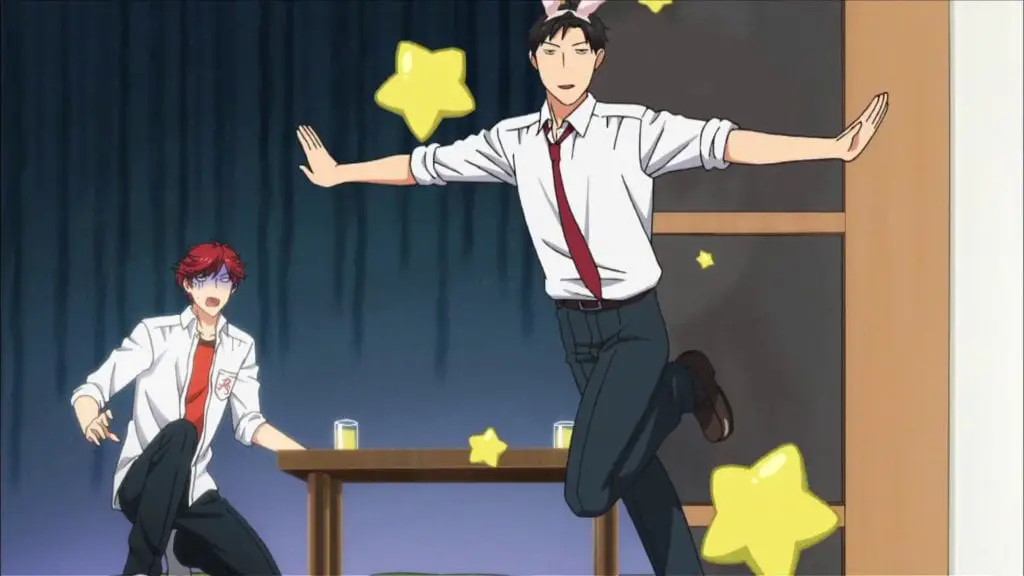
Don’t let that placid surface deceive you. This Strong Silent Male has a rich, vivid inner life. He gets really, really invested in his characters and story worlds. He likes to make up date scenarios for couples he sees at the festival (Episode 12). Other times it gets out of hand. When Mikoshiba asks for help preparing for a mixer (Episode 4), Nozaki gets “into character” as a female by wearing bunny ears while delivering weirdly sexual lines in his typical flat monotone. Sakura arrives to help out and he pulls her into the bathroom to have “girl chats” about Mikoshiba. And the scene where he and Mikoshiba write a love story for the male protagonist in a dating sim and his best friend. He instigates the whole thing because he gets so invested in the story life of the fictional character Tomoda. It’s the kind of behavior you expect from excitable, adorable Sakura, not stoic Nozaki.
He manages to be both analytical and artistic about his work at the same time. He’ll pick apart what makes riding a bike or walking in the rain sharing an umbrella romantic, trying to come up with the perfect formula. He’ll get so absorbed in his story that he loses touch with reality, even the reality of what makes a good manga scene. When confronted with issues of his drawing perspective (Episode 9), he fixes it by having characters standing on boxes rather than redraw his scenes.
Nozaki is even given a set of traditionally female coded skills and behaviors. He’s a great chef and wonderful host, and he shows it off quite a bit. He cooks for his colleagues almost every time they come help him with the manga. He meticulously makes bento boxes and brings them to his friends as a romantic gesture (to try out a scenario for his manga of course, but still). Even cutesy Sakura remarks to herself that Nozaki’s femininity is really high when it comes to his cooking skills.
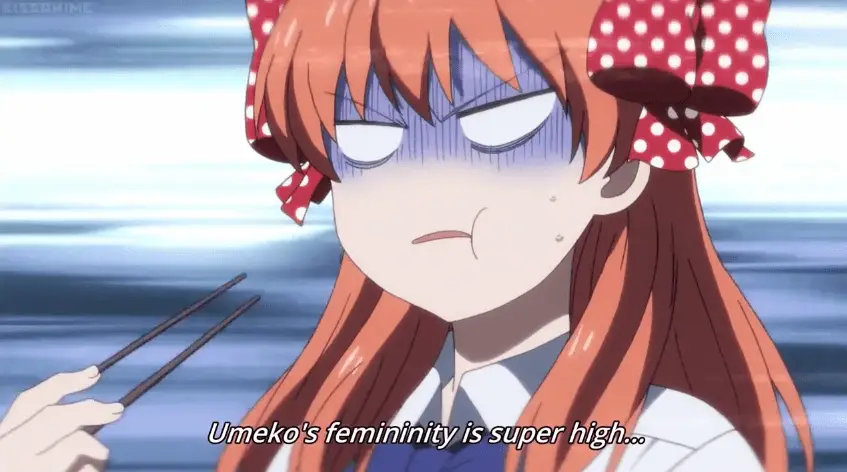
When his editor comes over to pick up a chapter of the manga, he excessively cleans his already sparkling apartment (which he’d meticulous cleaned the day before). Sakura remarks that its the kind of behavior one expects for a girlfriend, not an editor.
More than anything, Nozaki’s obliviousness to his own status as romantic interest marks him as not your typical male protagonist. Typically, the Shy, Quiet Girl is the one who fails to recognize that the Cool Guy likes her. She’ll be hyper aware of everyone’s feelings but the male who likes her. Welp, that’s Nozaki. He can analyze his friends’ love lives to a T (and then put them in his manga), but he can’t see how much Sakura likes him. He’s outwardly stoic, deeply romantic and artistic, and aware of everyone’s romantic potential but his own. Nozaki represents the idea that you can think you know what someone’s like based on certain gender-coded exterior traits, but you never know what lies beneath the surface.
Sakura/Chiyo
The girl of a million blushes and facepalms. Cheerful, friendly, naïve, and easily excitable, Sakura is quintessential adorable. She has a high pitched voice. She mumbles and stutters when she gets nervous and blushes at least twice an episode. She’s short and cute and has huge bows in her hair; there’s even a character who looks like her on Mikoshiba’s dating sim labeled the “kind classmate.”

She’s passionate, dreamy, and has a vivid imagination, much like you’d expect from a female protagonist in an anime. But she’s more than just a cardboard cutesy protagonist. She’s genuinely talented as an artist, even more so than Nozaki when it comes to classical style drawing. While she struggles to adequately express her feelings to Nozaki, that she repeatedly takes the initiative in the relationship and fails to give up when Nozaki doesn’t understand her overtures is normally a male characteristic in anime. Yet despite her failures, she is able to work alongside him as a colleague without becoming annoyingly clingy.
What sets her apart most from the kawaii (overly cute) anime protagonists is how easily she becomes the voice of reason for some of her friend’s antics. When Nozaki gets wrapped up in his far-fetched manga ideas, Sakura is there with a snarky quip about how unrealistic it is. When she discovers Mikoshiba and Nozaki sprawled on the floor after they pulled an all nighter writing Tomoda’s tribute, she rightly looks askance at their excessiveness. Mikoshiba’s tsundere behavior and girlish impulses annoy her as well, though they are still good friends. She’s typically the one commenting on how ridiculous everyone else is being. Like when Mikoshiba tells her to go get him coffee and, sensing him following her, remarks to him that his following her defeats the purpose of her going to get him coffee.
In Sakura, GSNK manages to have a leading lady who is primarily kawaii but without playing entirely into the stereotypical overly adorable female. She’s imaginative and excitable, but also remarkably down-to-earth, especially when it comes to how she relates to Nozaki and Mikoshiba. Their over-the-top flights of imagination and feminine characteristics bring out the more rational side of her. With them, she’s quite often the (more frequently male) voice of snark.

While she’s borderline obsessed with Nozaki, something her friends point out to her more than once, in her quest for his affection she never becomes a stalker. She gets jealous of Nozaki’s friendship with his female upstairs neighbor but is still kind and never catty or overtly jealous. She’s a testament to the idea that unrequited love need not turn ugly or annoying. And that women can be just as snarky as men.
Mikoshiba/Mikorin
At first, Mikoshiba seems to be your stereotypical tsundere cool guy: he acts aloof and cool when he first meets Sakura, but it doesn’t take long before he’s a ball of mush begging her to ask him to help her so that he can feel useful and needed. He’s the popular, cool guy whose top of the school, only he’s not actually top of the school (Kashima is) and he’s riddled with self doubt and easily embarrassed despite his “cool” exterior.
Much to everyone’s surprise, he’s the inspiration for the heroine of Nozaki’s manga, “Let’s Fall in Love”: sweet, shy, overly self-conscious Mamiko. And once you find this out, it makes sense. He’s romantic and emotional, quickly becoming invested in Nozaki’s headcannon of the dating sim they’ve been playing. Like Kashima, his effects are romantic and flowery, filled with bubbles, roses, and pastel colors. He’s even in charge of drawing precisely these kinds of effects for Nozaki’s manga.
Yet he’s also extremely self-conscious and frequently doubts himself. He’s actually kind of emotionally high maintenance. He is worried he’ll embarrass himself at a mixer, so he asks Nozaki for help. When asked to read lines for a play, he’s timid and quiet until bullied into confidence by Hori’s sharp commands. He’s easily embarrassed and in need of affirmation when he feels that way. Its actually quite surprising that Kashima’s superiority to him at everything leads to them becoming friends rather than enemies.
He’s also a bit of a nerd: he plays dating sims, which taught him how to talk to girls, and collects bishoujo figures (buxom, often scantily clad female figurines). Both of these hobbies would tend to imply he’s a bit of a creeper, but he’s so delightfully inept with women that its actually adorable. He’s genuinely a sweet guy, he just doesn’t know how to behave around women so he overcompensates. And then embarrasses himself. And then needs reassurance.
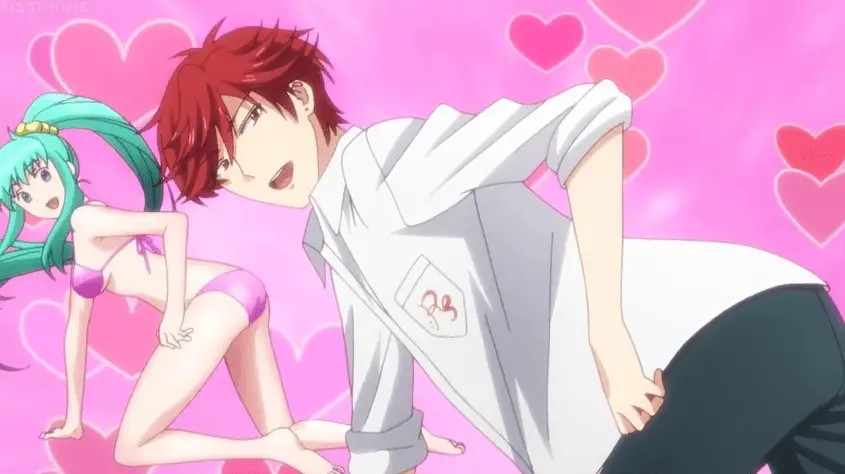
Him being the basis for Nozaki’s female protagonist alone is enough to raise eyebrows when it comes to gender roles. Isn’t the shy, self conscious, introverted one with fragile self-esteem supposed to be a girl? That’s what Nozaki’s manga depicts, and that’s what the media tends to depict as well (see Part 4!). And that’s kind of the point. Mikoshiba’s your standard anime female protagonist. Only he isn’t. But he still kind of is because of Nozaki’s manga.
Seo/Yuzuki
Seo wears her subversion on her sleeves. Better yet, she screams it then ends with a loud, raucous laugh. She’s tough, athletic, self-confident, oblivious to the inconveniences she causes others, convinced of her own perfection, teasing, loud, and has the emotional sensitivity of a rock. She’s your typical high school jock, but with boobs and great hair.
This is nowhere more true than in her relationship with Wakamatsu. She picks on him in basketball because she thinks its funny. She nicknames him Waka. She takes him to see a B movie about an alien invasion, is bored by the emotional scenes and character development, and then teases him when it scares him. She steals his armrest and his popcorn in the theater. When he confronts her about his anxiety over her behavior, she is oblivious to what he means.

Yet Seo is not just a one-dimensional quasi-bully. She has a beautiful singing voice and is dubbed the “Lorelei of the Glee Club.” Plus, her actions aren’t played off as mean-spirited. She’s honestly just totally oblivious to how her actions affect other people. She literally has an entire conversation where she walks across posters and through people taking photos while she spouts how wonderful she is and muses about whether or not she’s “too perfect.”
She seem to genuinely think Waka will laugh with her about her teasing. Either that or she doesn’t realize that laughing would hurt him. She’s blunt, but not a bitch. She’ll compliment a girlfriend on a new purse, and then say it looks like the one her tacky neighbor has. She’ll tell Kashima that her voice is horrible, but still offer to help her with music lessons (Episode 11).
I love that she’s played in such a masculine way and has masculine themes surrounding her, but it doesn’t in any way make her a boy. She’s a character who in most mangas or animes would be male; indeed, when Nozaki uses her as the inspiration for a character in his manga, that character is male. Even her effects are more masculine, looking more like a samurai or warrior background than your typical cutesy feminine effects.
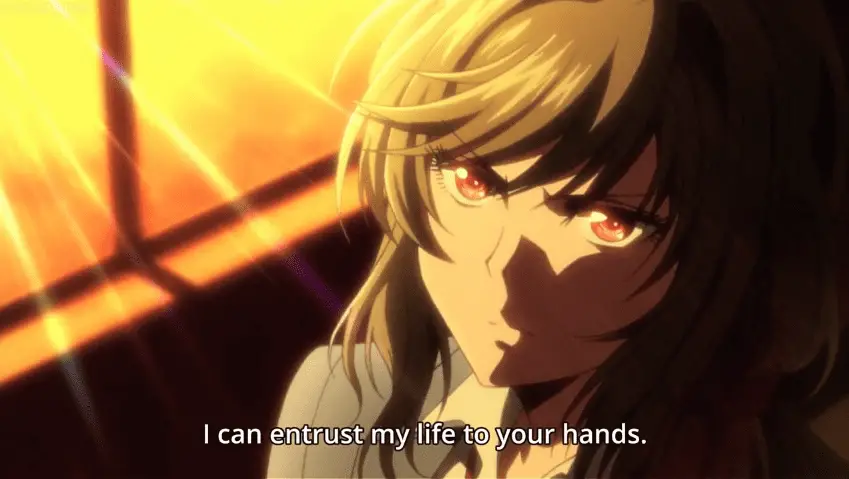
But she’s not played off as butch either. She has pretty hair (seriously, I envy this girl’s stylistically messy braid), a pretty face, wears traditional feminine clothing (though slightly rumpled), and hangs out with kawaii Sakura. She’s tomboyish, but still very much a girl. Not that her existing as butch is inherently a problem at all. But the butch tomboy is a stereotype in and of itself and one I’m glad GSNK has avoided. It’s has managed to pull off the epic feat of a rough-and-tumble, emotionally oblivious female without making her an absolute terror. It’s impressive.
She’s not what you expect from a female character, but I find her endearing and funny. She actually reminds me a lot of one of my friends growing up, which may be why I like her so much. She’s athletic without being a total jock (since she’s also in glee club), she’s blunt without being intentionally mean, she’s hilariously oblivious, and always good for a bawdy joke. She doesn’t fit the mold of a standard female anime character and proves that women can be oblivious and loud without being obnoxious.
Wakamatsu
Wakamatsu is the polar opposite of Seo. Given Seo’s more masculine coded traits, Wakamatsu understandably winds up with more traditionally feminine coded traits. He’s gentle, emotionally sensitive, anxious, and fixated on who Seo might (or might not) be dating. He also likes romantic comedies. And nice dinners. And dressing up for dates. And getting dating advice from shoujo manga. And accidentally writing love letters and giving gifts when he’s trying to be confrontational.
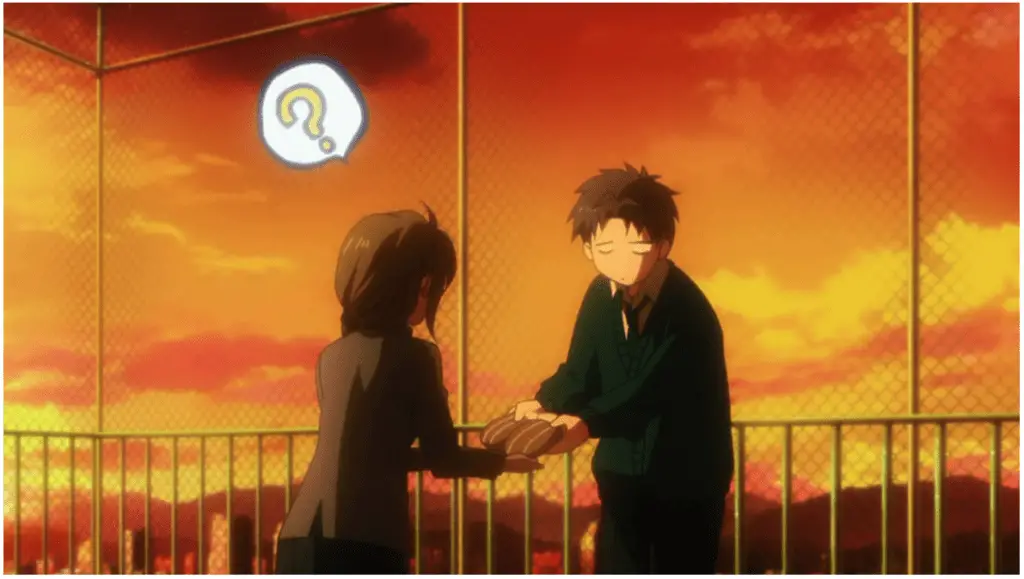
He’s also the only one (other than Sakura) who seems to specifically care if the person he likes is dating someone. His powers of imagination and projection rival even Nozaki-kun. In the Episode 12, he sees Kashima with Seo and assumes Kashim is Seo’s cool boyfriend and is only hanging out with Waka to make Kashima jealous. In the DVD specials, he goes out of his way to find out about Kashima and Seo, only to accidentally look like a pervert and eventually discover that he as nothing to worry about because Kashima is a girl. It’s the kind of behavior you expect from a girl like Sakura. He’s also genuinely a sweet guy. If Mikoshiba is a teddy bear, Wakamatsu is a puppy. A big-eyed innocent, gentle, soulful puppy. He selflessly offers to help out on Nozaki’s manga and earnestly wants to be friends with everyone. In short, he’s the cinnamon roll, and I honestly don’t know how he puts up with Seo’s shit most of the time.
Kashima
Dear, dashing prince Kashima. Who would have expected that the prince of the school, the one all the girls are in love with, would be a girl herself? Kashima is everything a stereotypical manga/anime “prince” character ought to be: charming, attractive, sweet, people-oriented, flamboyant, dramatic, and full of romantic one-liners. Sappy, romantic affects follow her wherever she goes. Like all prince characters, there’s something irresistible about her charm to the ladies at school. She pretty much always has a gaggle of girls at her heels, usually accompanied by hearts and giddy sighs.
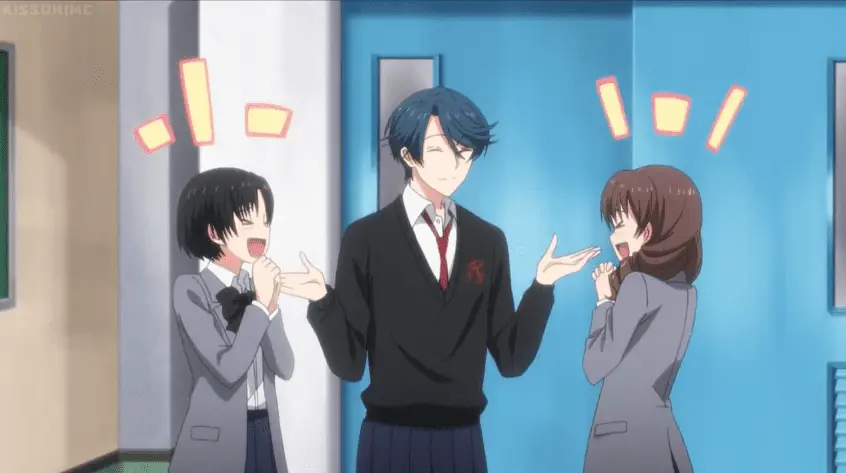
Her popularity for the ladies is typically used for comedic effect. In her first episode (Episode 3), Hori dismisses her from painting sets because all the girls keep making purposeful mistakes so that Kashima will console them. When she opts to go to a mixer instead of Mikoshiba in Episode 4, the boys are excited that the girls will now outnumber boys. But much to their chagrin, Kashima steals all the girls away. Hori even says that he’d never tell Kashima if he were to have a girlfriend because Kashima would probably steal said girlfriend.
Nevertheless, GSNK manages to make the laughter not be a mockery of Kashima’s behavioral choices, but rather about other people’s expectations of her. No one acts as if her having women fawning all over her is gross or weird. She’s the “Prince of the school.” That’s who Kashima is.
Her violation of traditional gender roles plays out even more strongly than with Seo in that she also dresses in a more traditionally masculine way. She has a more boyish haircut and wears a sweater and tie rather than the girl’s blazer and bow, though she still with a skirt. In casual clothes, she opts for button-down shirts and running jackets like Mikoshiba wears.
She’s frequently mistaken for a male by other characters. When Sakura first meets her, Kashima’s skirt confuses her. In the DVD specials, Wakamatsu spends the first three episodes thinking that Kashima is Seo’s boyfriend. This doesn’t seem to bother Kashima at all. In fact, when she thinks Hori is into manga because he secretly wants to dress like a girl, she reacts by leaving her skirt for him in his locker for him to wear home.
This rather nonchalant attitude toward blurring gendered lines of dress and conduct is impressive for a high school rom-com anime. True, the situation with the skirt in the locker is played for laughs, but the humor focuses exclusively on Kashima’s misunderstanding of the situation (Hori had Nozaki’s manga because he was helping work on it, not because of a desire to dress like a girl), rather than on the idea of Hori wearing a skirt. The message from Kashima’s character seems to be that a person should wear and act however makes them feel comfortable and themselves, even if it blurs other people’s perception of their gender.
Hori
Hori is Winry Rockbell from Fullmetal Alchemist Brotherhood. He’s the long suffering, intelligent, capable woman who has to put up with a doofus male who messes things up unintentionally. Only he’s a he and the doofus male is Kashima.
Unlike the other males, he isn’t given feminine coded traits. He’s a fairly straightforward male character in personality. His subversion comes in the form of his height handicap. He’s significantly shorter than the rest of the males and a good head shorter than Kashima. While he’s the most talented actor in the school, his lack of height prevents him from being the lead because no one can imagine a short leading man. So he’s relegated to directing the plays and keeping Kashima in line.
He’s also the only character to be measured against a specific standard of beauty or appearance, something normally reserved for female characters. As a dramatic lead, he’s expected to fit a certain standard and he falls short (heh). But in the way that only GSNK can, the replacement male lead doesn’t actually fit the standard either because its Kashima. It’s a not so subtle comment on a society that would rather have a male lead meet a certain standard of beauty/height than actually be male.
Conclusion
Whether its Mikoshiba who comes off cool and aloof, but is truly deeply shy and uncomfortable around most people, or princely Kashima with her gang of lovesick girls, there’s something to baffle every gendered stereotype found in typical shoujo anime. And each of these subversions has something to offer the audience. Seo’s tomboyish obliviousness proves that women can be more than just cutesy love interests. Kashima’s charm gives her the freedom to be the object of women’s adoration and express her gender however she wants. Sakura comes off at first blush like a kawaii little smol, but she’s highly pragmatic and the voice of reason for Nozaki’s more flighty artistic temperament.
Then there are the boys. Wakamatsu and Mikoshiba both depict men that are more passive, emotional, and high-maintenance than the women they’re surrounded by. Nozaki comes off as stoic and unemotional, but is really an over-the-top, day-dreamy artist who is completely unaware of his own status as an object of romantic attention. These three occupy roles most commonly given to women in anime just as the women occupy roles traditionally given to males. With Hori, the subversion of tropes has less to do with him being coded with traditionally feminine traits and more to do with being given a handicap (being short) that many would think handicaps him from being a Strong Male™.
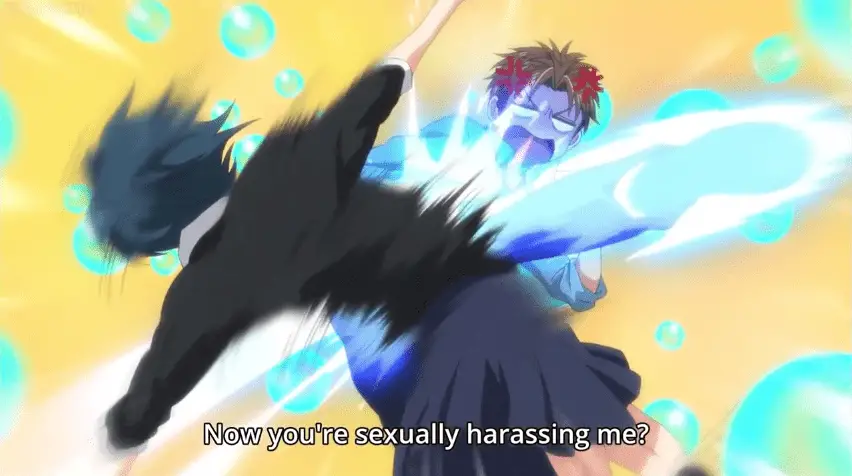
GSNK proves that tropes are well, just tropes. They’re based in fiction, not in the reality of every day life. These characters exists as they are without judgment or condemnation within the universe. Kashima just is the prince of the school. Mikoshiba just is the inspiration for Nozaki’s female protagonist. They’re real people, flaws and all. And they’re honest and straightforward and comfortable being themselves more than most of the characters in an anime or manga. Men and women just are who they are and tropes are mere shorthand conventions.
It’s brilliant writing and brilliant social commentary, but before I get to that, I’ll handle the friendships and romantic relationships. Hint, there’s lots of ship-baiting, but not so much that you get tired of it. Plus, girls being friends without being catty. What?!

